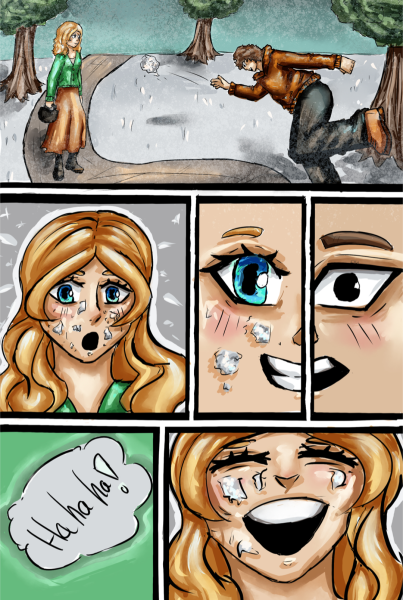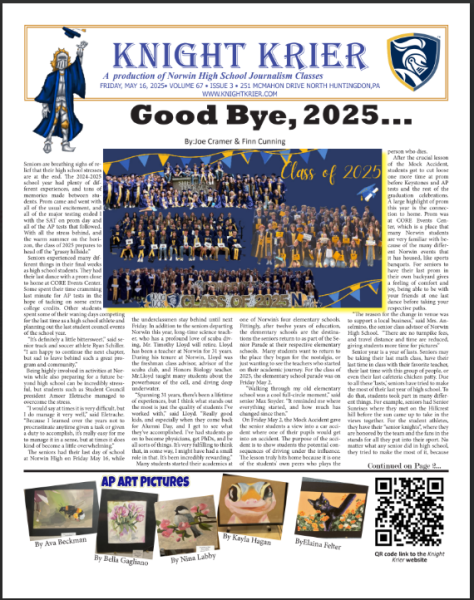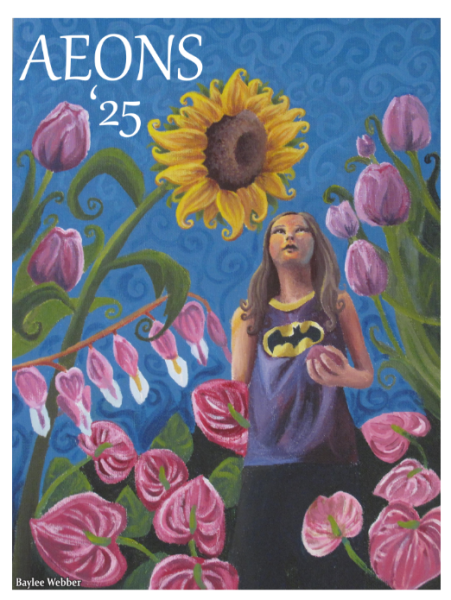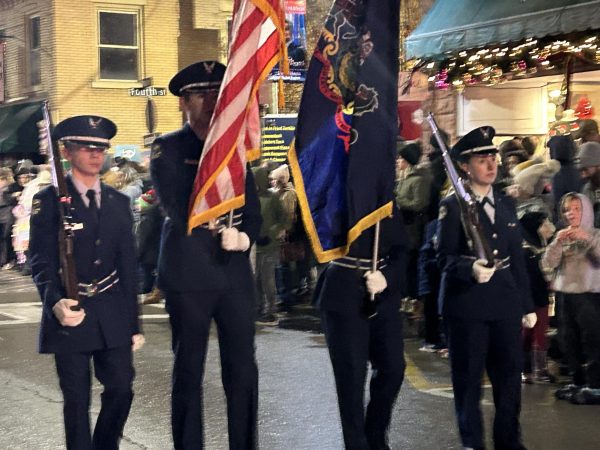KREATIVE KORNER: The Small Art Museum Across the Street by Ray Mamas
The following writing piece was written by Ray Mamas, an AEONS contributor and creative writing student at Norwin.
Name: Ray Mamas
Title: “The Small Art Museum Across the Street”
Date: June 2022
Inspiration: I wanted to express music in a different way than normal through other forms of art. It was fun to think of the visual artworks that would go with each song, and then to figure out a way to pain that picture with words. The outside of the gallery is explained to be simple, similar to how each of the artworks are done on everyday items, to show how something so simple could still be extraordinary. It was also fun to use the lyrics of different songs to explain them in the writing. The piece is one of my favorites I have done.
I lived in an old and dingy New York studio apartment, where my only roommates were the rats that would wander in occasionally and the wretched smell of broken sewer pipes, but the rent still somehow happened to be just under what my salary could pay for. On the ‘good’ weeks, I was fortunate enough to be left with a few extra bucks for the subway and a small meal most nights. Luckily, the nearby dinner I worked at served its employees breakfast and lunch. I’ll tell you this now, being a young artist in New York was not what the movies made it out to be. Once in a blue moon, there would be one of us who made at least some sort of impression on someone of at least some importance and then they would hit it big… but that blue moon hadn’t visited in a while.
There was one good thing about living where I did, and no it was not the donut shop on the corner that threw out their extras every night, and if you were to time it just right you could catch a full batch of boston crème right before they dumped it, no no it was not that. The wonder of that rundown neighborhood was the magical mystery of the small art museum across the street, and I had the perfect view of it from the single window above my bed. It sat cramped between two larger buildings, which hid it from the sunlit sidewalk. One would never be able to tell or even believe what lied inside unless they were to venture in themselves, and one day the curiosity got the best of the cat. It was mid afternoon on a Wednesday if I can remember correctly, and I had just enough saved up in my change jar labeled: “Spare Change Found at The Laundromat — save for a dream” to buy an entry ticket for the mysterious gallery. I would explain the inside as a small square room where the unexpected, but still ordinary, hung on all four walls; and a small desk sat in one corner, used by one to collect money for entry. Yes, I know the inside was no grand palace of marled floors nor glittering chandeliers, but the art was something not of this world. Each piece had its own individuality that was explicitly different from the last. They all came with a feeling of familiarity but at the same time, they were like nothing I had ever seen before. The first work I found myself upon was a black and white pencil sketch, on what looked like to be an unfolded cafe napkin. The drawing’s main attraction was the pale woman with a long face and big eyes, who stood close to the forefront. She had a bony face that was outlined with sharp features, excentrating the long skinniness of her face; she looked—ghostly. She seemed to live in her own imaginary world, where she secretly wore the face that was only kept in a jar by the door. For who? Well that was the enigma hidden within her. Around the woman were small staggered figures of people, lonely people, who lived in a far off dream. No one knew where they all came from, or where they all belonged. Yet, they were all gathered together—but shaded in, oddly resembling shadows of imaginary people who weren’t really there. She was a stranger to them as they were to her. Cloaking the whole picture with a secretive dark feeling, was the haze of a shaded gray color around the corners of the napkin, that got darker the further they stretched out. The thing that bothered me most about the drawing was the idea that this long faced woman would die in the church and be buried along with her name, for no one would ever remember her. When this woman passes on, nobody will come and no one will be saved. Its title was “Eleanor Rigby,” its artist: “The Beatles.”
I walked on to the next work hanging on the blank gray wall. This was nothing like the other had been. It was an acrylic painting done on the back of a postcard sent from Brixton, London. Illustrated on the postcard was a crowd of children looking hopefully towards the hazy cosmic jive sky. The sky was done in bright vibrant colors with distinctive brushstrokes that created happiness within the painting, a promise of joy. But, the crowd was done in a deepened dark blue that when focused too closely on, turned to flat black. The children longed for the sky to gift them the exuberance it had promised, but the sky was frozen in a moment where it would never do so. It wanted to go and meet them but was too scared it would blow their minds. So the sky sat, waiting, and only from afar, told the children not to blow it; because it knew it was all worthwhile. The needy children were destined to lose their hope in the sky; because as time passed, the sky only felt like a fictional character created to ease their troubles. For in the world where the art subsided, the children weren’t allowed to lose it and they weren’t allowed to use it. Who would return the stiffened children’s stolen euphoria and save them from the lost world? — Maybe one day, the sky will fulfill the promise it had made and let all the children boogie. Its title was “Starman,” its artist: “David Bowie.”
I backed away from the painting and over towards the other side of the room. The new art I was now admiring hung in a golden frame, on a wall painted light blue. I noticed that it was the only piece in the whole gallery that sat inside of a frame. The reason, well, that I didn’t care to ask about that. I decided to let it keep its selfish ambiguity. I would only remain to imagine it was because the art was trying to hide her imperfections by surrounding herself with a frame of golden lies. To say the least, it was an overly magnificent frame for the small artwork. Between the two panes of glass, a book page laid next to a dead flower- whose color had gone and whose existence was lessened by the pressing of the closed glass. The title of the book, which was still visible on the top of the page, read “King Louis XVI and the Tales of Death.” Drawn onto the page was the hopeless scene of a fallen king along with his fallen kingdom. It was done in jagged, yet elegant, brush strokes of a calligraphy pen; mainly consisting of lie telling black with hints of royal gold and darkened red accents. The king who once stood tall and colorful, illuminated by the joy and loyalty of his people, now kneeled limp like a puppet on a lonely string. His face showed pity for his own, illustrating the hunger he had for the old world’s return. He longed for the time when the seas would rise as he gave his words. His ears yearned to hear the song of his crowds once more, and his heart burned for one more time where he could feel the fear in his enemies eyes. He begged, looking up to where his castle now stood on pillars of salt and pillars of sand. Never an honest word was spoken in the land of the fallen king, but if you listen closely, you can hear the silent echoes of the passed people. “Long live the king,” they once said. Its title was “Viva la Vida,” its artist: “Coldplay.”
I then walked over to where a ripped off corner of the local newspaper was clipped to the wall. Scribbled down on it was a small heart, plain and done with a basic red pen. But it didn’t allow that simpleness to take away from the meaningful story concealed by the effortlessly drawn lines. The heart on the page was no longer whole as it had a small crack through it separating two pieces. Unlike your stereotypical drawn broken heart, this one was unbalanced. One side of the cracked rift was large and full of contempt for the brokenness, the other side was small in despair— because when a heart breaks, no, it doesn’t break even. The larger side is at peace and carries on her life like nothing happened. She continues smiling with ease while the small piece lives his days in agony now, missing her more than ever. Her best days will be some of his worst, because she has finally found someone who is going to put her first. She has no trouble sleeping at night, while he lies awake in his empty bed, missing the weight of the gone body that used to lay beside him. She was his purpose in life, and without her, he had lost his light. She had him falling into pieces, praying to a god that he didn’t even believe in. For what was he supposed to do when the best part of him was always her? Its title was “Breakeven,” its artist: “The Script.”
The final work of art I came across in that tiny museum was the largest one in the gallery. It was no giant piece of sculpted stone, but it was surely marvelous… a marvelous piece of printer paper. In the corner of the 8×11 paper there was a stamp from the mailing office that resigned up the street. Filling the blank paper with bright colors was the painted picture of a late night city where two strangers would soon meet. The city whose smell was that of wine and cheap perfume. The city whose boulevard was lined up and down with streetlights glowing like stars. The city whose shadows searched in the night, and whose movie would never end. Through the city, two strangers rode the midnight train going anywhere. They were two lost souls looking for their reasons in life, dreams of their own. They were as lonely as lonely gets—not even emotions would stick by them. They both needed to find someone who could relate, who could fill that void, who could return each other to humanity. Would they ever meet and become more than distant beings, or would they remain strangers of the night? They held onto the feeling of hope that they would someday meet, and so neither of them would ever stop believing. Its title was “Don’t Stop Believing,” its artist: “Journey.”
I backed away from all the artworks and stood in the middle of the small gallery. I paused to reminisce on them all one more time. Not one of the artworks was of a known artist, or on a grand canvas, no, they were done on everyday things by your everyday people. None of the pieces needed to be worth striking amounts of money to have significance to the artist or the viewer. None of them belonged in magnificent museums or bustling auctions, where they would only be seen for their dollar value. They belonged exactly where they were, in the small gallery where each and everyone of them could shine against the plain walls, and be truly appreciated for its own beauty: the lonely woman who would now not be forgotten, the hopeful dream that had now become reality, the fallen king who had regained his name, the broken heart whose pain is now known, and two strangers who I know will meet one day.
I could leave that gallery in certainty and peace, finally knowing what had stood on the inside. So as I left, I waved a slight wave to the person at the desk, and I swear they were wearing a blue moon pin…








